Birds were created on the 5th day of creation
20 Then God said, “Let the waters abound with an abundance of living creatures, and let birds fly above the earth across the face of the firmament of the heavens.” 21 So God created great sea creatures and every living thing that moves, with which the waters abounded, according to their kind, and every winged bird according to its kind. And God saw that it was good.
Genesis 1:20-21

About The Budgerigars
Or better known as parakeets
Parakeets come from Australia. The Parakeet can live in up to 110 degrees. They do this by resting in the shade, with wings lifted off the body (but not spread out), and panting. Of course this is not so with pet parakeets. Pet parakeets are not accustomed to such extreme heat, because they are normally kept inside.
An average life span of a parakeet is about 10 years. Although in rare cases they can live to be 20. They originally only came in the color green. But as they became pets, and were bred in captivity, a mutation took place. Now they come in many different shads of blues, yellows, whites, greens, and so on. A very rare colored parakeet is a creamino parakeet. They have red eyes, and are a light yellow canary color not a dark yellow. Normally, the creaminos are females. This is photo of a baby creamino parakeet. As she gets older her color will darken, but only slightly as most parakeets do. Lutino parakeets are much darker yellow than a creamino. Also, a lutino parakeet can be all white it just needs to have the red eyes.
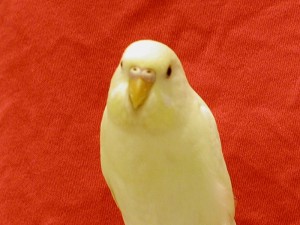
Difference between adult Male & Female (look above the beak at the cere).
Adult females should have a chocolate-brown cere.
Note: Sometimes adult female parakeets never change to a brown. Instead they stay a white/yellow/light-blue color.
Adult male parakeets have a beep sky blue-purple cere.
Difference between baby Male & Female parakeets
 Baby female parakeets usually have a white ring directly around the nostril, then a little bit of yellow, and as you continue to look even father from the nostril holes it is a light blue.
Baby female parakeets usually have a white ring directly around the nostril, then a little bit of yellow, and as you continue to look even father from the nostril holes it is a light blue.
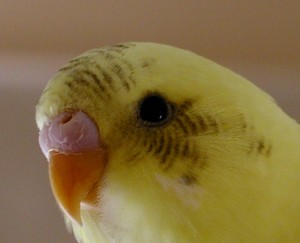 Baby male parakeets usually have pink-purple cere.
Baby male parakeets usually have pink-purple cere.
Note: the older the baby parakeet is the easier it is to tell its sex. You can tell at about 4 weeks old. Also another way to help you sex a baby parakeet is it’s attitude. Male parakeets are almost always nicer than female parakeets. When a baby parakeet bites you, does it nibble or clamp it’s beak down on you? Usually the female clamps down on you and will not let go for a bit. But a male usually bites more gently or nibbles.
Care Information
9 Steps Caring For Your Parakeet
1. The size of the cage should be 23″ long 16″ wide & 14″ high. This is suitable for 1-2 parakeets. Of course, cage shapes vary, the measurements above are for a rectangle cage see the two photos below.
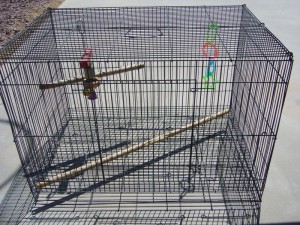
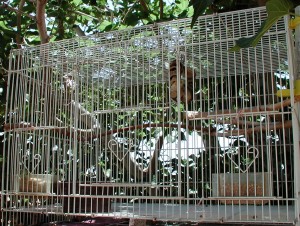
2. You need a cage, with a bar spacing, no wider than a ½ “. Otherwise the parakeet can get its head stuck between the bars.
3. You will need a good seed food. Look for a seed without pellets and colors. Most parakeets will not eat a diet with pellets because it is not natural, and the dye in the pellets is not good for them. The millet seed should never be more than 50% (this is a whitesh ball seed in the photo below). It should have 50%, or more, of the tan elongated seeds. The ideal seed should look like this photo below.
4. Give your Parakeet(s) a cuttlebone and place it near a peach. The parakeet will chew on it and will help keep the beak filed down; otherwise the beak may require trimming from time to time.
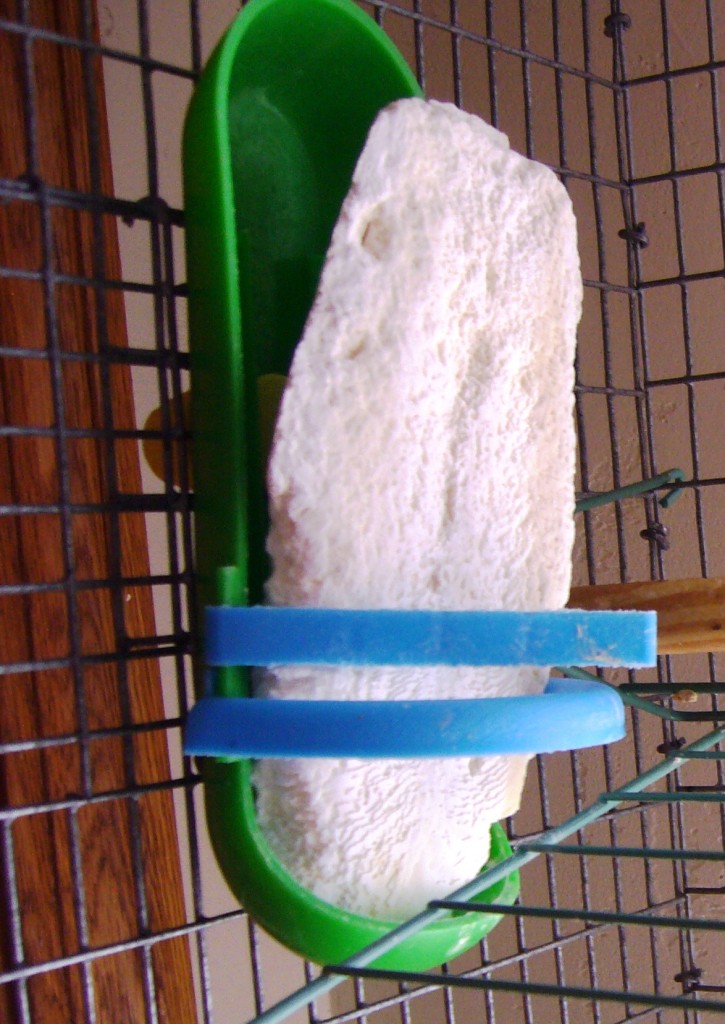
5. Birds need something called grit. Because birds do not have teeth, grit will help break down the seed and make it easier to digest. Also, grit has minerals that are good for birds. Look for a grit that has oyster shells in it as this is very good for birds. Grit varies from brand to brand, and it also comes in different sizes; some are fine like beach sand, some are more rocky than fine, and some are bigger chunked. Depending on the breed of bird will decide on what size grit should be given. For small birds such as finches and some canaries they would need a grit that is finer, more like beach sand because their beaks are small. Parakeets need a grit that is bigger and less fine. For larger birds they need a rockier and bigger chunked grit, like the size of gravel.

6. Give your parakeet(s) veggies and fruit 1-2 times a week. Make sure you do not give too much fruit or your parakeet(s) may get diarrhea. Never give any bird avocado! It is toxic to them.
7. Blow out the left over seed shells twice a week.
8. Change the birds water twice a week, or more as needed.
9. Change the cage tray 1-2 times a week depending on how many parakeets you have in the cage.
All comments will be reviewed before they appear on this page. Usually comments take less than 72 hours to be approved. Once your comment has been approved, you will be able to leave new comments that will post instantly.
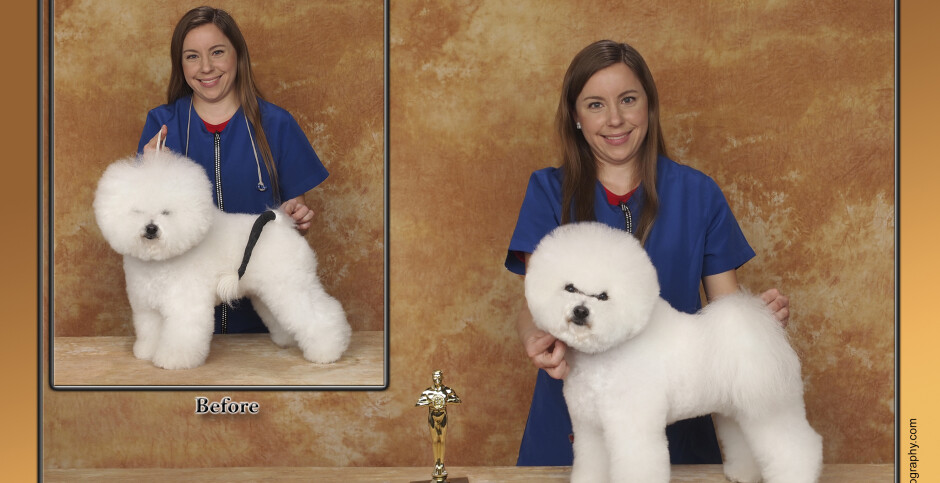

Hi Arby,
It sounds like you do have a male and female 😉 Often the males do head bob, feed the female, and talk away to her. If you are looking for some birds to just observe in the cage it is fine that you have the two together. But if you are looking to tame the birds they are not going to like you as they would much rather just be left alone together in their cage. They may breed but only if the conditions are right. Don’t give them a nest unless you want babies.
I have, what I thought was a male, but it’s cere turned dark brownish red recently, and I had bought a companion..what I thought was a female, but now think it is a male. This is a good thing, but I’m not sure. The one I just bought does alot of head bobbing and feeding into the others beak, and is more “vocal”. Does that mean that its a male? I can send a picture if you want..thanks. (ps. I wish people at pet stores knew about the sexing of birds….it would really help) 🙁
Hi Nicole,
I sounds like you do have a female. If you want, you could email us a photo of your other bird and we can give you our guess if the info above did not help you. As for the fruit make sure you do not give too much. You can five them fruits like apples, bananas, or grapes.
Hi I have 2 questions. I just bought 2 parakeets believe I have a male and female but it is very hard for me to tell. I know for sure that I have a female because of her brown cere but i cannot tell if the other is a male or not. And im not sure how old the parakeets are. And I seen that you feed them fruit. Is there certain fruit that they cant have?
Hello again Alice Mckee,
Your nest box sounds big enough (most parakeet nest boxes are 7″ L X 6.25″ W X 9.5″ H). It sounds like your hen just wanted to move out the first babies to make room for another clutch. Glad you are enjoying our website 🙂
Thank you so much I am learning so much from this site. I’m glad it is here. All the babies are out of nextbox and I have removed it. The mother is mean to the babies so I am going to remove her from the cage. And according to the way they act I think I have 2 male and 2 female babies. The nextbox I used was a birdhouse with removable top for cleaning and checking on birds the measurements are about 5″ x8″ i would have thought it would have been big enough. She surly did wean them early, the dad did a lot of the feeding once everyone was out of box but mom won’t let the female babies around her she knocks them off the perch so they sit on their own perch and her and dad sit on another. I have toys in the cage and the babies play with them. Thank you againfor your help
Hello Johnny F.,
Yes it is harder to hand tame a flock of parakeets as apposed to a single parakeet. Parakeets naturally want to bond with each other if placed together, and there is no reason for them to like a human when they already have plenty of playmates. Male parakeets are usually essayer to tame compared to the female. You might consider taming just one parakeet from your little flock and placing him in his own cage in another room and working with him daily. You can find helpful tips on taming a bird under our “Creature Care Tips” just look under the bird page.
Hello Alice Mckee,
For your first question about the mother kicking the older two out of the nest, I’m not sure why she did this. If you are using a parakeet nest box and not the finch nest box then the hen had plenty of room for her family of four. If you are not using a nest box but rather some kind of bamboo nest, it would be very easy for the older chicks to fall out. Another suggestion as to why she kicked out the 4 week old chicks is maybe because she wants to wean them faster as she wants to start a new clutch of eggs.
For you second question, I would recommend separating the two parents to give them a rest. You can take the cock out with the older babies and place them in a cage next to the hen’s cage. The other babies with the hen should be taken out of the nest box as soon as they are old enough (about 5-6 weeks). When the babies have all been removed from the box, take the nest box out of the cage so the hen won’t lay more eggs. If the hen is already laying in the nest box remove the eggs as she lays them then take the box out.
If your hen and cock have lost a lot of weight from raising this last clutch, it can be life threatening to the parents (and future chicks) to allow the pair to raises a second clutch consecutively. Whenever you breed an animal they always need a special diet to enable them to maintain their body weight and meet both theirs and the offspring’s nutrition levels. Also you need to be sure you condition the animal(s) before breeding (i.e. make sure they are healthy and not skinny). Thank you for your question and we hope you find this useful.
Hello- I have 4 parakeets,pretty sure 2 male,2 female. They all seem happy and healthy but I was wondering how hard it will be to train them out to exercise,go on a finger,etc. At feeding time they’re all pretty gun shy anytime I enter the cage or change the dishes. They seem to travel as a flock away from me. Will this change? I had one parakeet 30 years ago and getting her out and on my hand was easy but it seems with multiple birds its going to be tough. Thank you-j
I have a pair of parakeets they mated and have successfuly hatched and raised 4 babies the oldest is 5 weeks old. I have 2 questions. the mother kept kicking the 2 older babies out of the nest box when they were 3 to 4 weeks old. was the box too small? I removed the box at this time but the youngest wasn’t completly feathered. They are still doing well and they all have their feathers and 3 can fly great. Now the parents are mating again and as I’ve been reading (also I don’t want them maiting this soon) I find it is too early, what do I do, do i seperate the parents and if so which one do I remove to the smaller cage? I want to do this right. I had read somewhere to discourage mating change the things of the cage like move toys, change perches things like that and they won’t feel it is a safe enviroment to raise chicks in. but this hasn’t worked for them. Pleae give me pointers. I’m glad I read the other questions bc I haven’t been feeding my birds the right amount of millet my food has more of that than anything. Thank you for your help.
Hello Michaela passarello,
You can email us a photo of your birds and we can give you our opinion. If they are babies it is possible that the pinkish blue is a male, the pinkish white might be a female, the light blue and pink might be a male. Sending us a photo and age of the birds will help a lot, thanks.
Hi! I have 5 parakeets. I’m more than sure that 2 of them are males. But I have 3 others that I’m not to sure about. They all have pinkish blue,pinkish white, light blue and pink Ceres. I just want some legit answers because everybody gives me different answers. Thanks! Michaela passarello
Hi Carol,
If the babies are eating on the own just fine, then I would take the daddy out. You don’t want them to inbreed later on, if it is a female that he is bonding with. Also giving the dad a rest from feeding the babies will help him put some weight back on if he lost any. When I was breeding I would always rest the parents otherwise they would just continuously raise chicks and this would have killed them.
My parakeets have had a successful mating with the hatching of two babies. It is now nine weeks later. I had seperated the two baby birds in a seperate cage but let the father visit the young. It seems that he only likes one of the birds. He kisses it and feeds it. The other bird he does not like, nor does that baby like him. The baby attacks him when he feeds the other baby bird. Is this normal? or, perhaps this baby bird is a female and he is attached to her. I do not know their sex. The babies could be either male or female. I do not know. How should I proceed with them. The father bird would rather stay with the baby then go back to his own cage with the female mother. Thank you in advance for your thoughts on this.
Hi Suz,
Your breeding pair can be separated if you do not wish to breed them. But if your female has eggs that are fertile, put the male back with her because she will need the male to help feed the babies when they hatch. If you do not want them to raise babies remove the eggs. If you decided to let them have babies you should separate your breeding pair after they wean the babies. Your breeding pair needs a rest and should never be allowed to breed continuously as it will eventually kill the parents because they lose body weight when feeding and raising babies.
I have 6 parakeets: 2 female, 4 male (I think). Two mated, and we were able to separate them into a cage with a nest box. The male doesn’t go in the nest box, but he does stand on the perch outside. He may even feed her from there, but the nest box blocks my view, so I don’t know. We have 7 eggs of 8 total laid. The first was destroyed by its mother… we did not have a proper nest box. Today, I accidentally let the mating male out of his cage. Now he’s back in with the others. He doesn’t seem bonded to the laying hen. Can I just leave him with the others, or must he go back to the breeding cage?
I was wondering if you could help me with ideas on how to get skyler handtame . Just in the past few days I’ve been able to teach sunshine to “step up” and “step down” but skyler wnt evn let me get close enough to touch him. He flies around his cage so I just give up bcuz I Dnt want him to hurt himself or sunshine.
Well the remaining chicks have grown up nd r almost flying now. Unfortunately I wasn’t able to get a pair but my husband Jst got me a pair. Yellow, red eyed female thay ive named sunshine she is semi holdable. She nips every now and then but not to bad. Nd then the male is blue and white nd I’ve named him skyler bcuz it looks like he has a cloud on his chest. He wnt let me pick him up @ all. My husband said it wouldn’t hurt to clip his wings so he doesn’t fly to much but I think its cruel. Sunshine for sum reason cnt fly. She flaps her wings nd glides about 5-10 feet then Jst stops flapping nd hits things.
Hi Dakota,
So sorry that some of the chicks died 🙁 It is hard sometimes to know what went wrong in situations like these.
Here are some things that may have caused the death of the chicks:
Inexperienced parents that did not keep the chicks warm or feed them properly
A parakeet entering the nest box that was not the parent and killing the chicks
The nest box being disturbed too much by people so the parents don’t properly tend to the chicks often enough
The temperature became too could (this would only be the case if the birds are being kept outside)
The nest box was too small and crowded so the chicks became smothered
The parents were related or of poor quality thus producing week chicks
And there are lots of other things that may have caused this problem.
One thing to always remember is that whenever breeding animals at some point you will see death. Sometimes you are able to help the animal and save its life, other times there is nothing you can do to prevent it. Keep doing what you are doing, looking into the situation. This may have just been an accident and will not happen again, but if it dose then you know there is something wrong. If you can find out what is happening then you will be able to fix the problem.
Thank u. The other egg hatched a few days later but the older chick squished nd killed it. Nd only 2 of the other batch of eggs have hatched. I went over to her house to see the first hatched chick nd he was perfectly fine. My friend messages me this morning to tell me that the chick died. She said she checked him nd he was laying on his side nd his head was all wobbly. What can make a chick go from perfectly healthy chirping to die 2 days later.
Hello Jessica,
If the info and photos above did not help you, you could email me a clear photo of the bird’s cere. I can give you my opinion but it may not be accurate (it can sometimes be hard to determine the gender of a parakeet by just looking at the cere). You can email me at Contact@GodsC.com
i got a parakeet the first week of December he/she walks in circles when it wants out and he/she also has a lite purple/brown beak how can i tell if its a boy or a girl?
Hi Ashley
If the info above did not help you, you could email me a good clear photo of the bird’s cere. I can give you my opinion but it may not be accurate (it can be hard to determine the gender of a parakeet without seeing it in person). If you decided to email me a photo include the birds age, thanks. You can email me at Contact@GodsC.com
Hi Dakota
Parakeets lay their eggs about 2 days apart from each other (they lay every other day). The eggs will also hatch about 2 days apart from each other. You can candle the eggs using a small bright LED flashlight to see if they are fertile or not If they are fertile they will be dark inside (find more info about this by typing in the search box “candle eggs”). The babies should be weaned at about 8 weeks but sometimes it can take longer. If all goes well you could take the baby Parakeets home when they are 8-12 weeks old.
I am trying to figure out if my new parakeet is a baby boy or girl…. Can you help me?
My friends parakeets Jst laid eggs. She has 2 males nd 2 females. So 1 female laid 5 nd the other female laid 2. 1 of the 2 eggs already hatched. How do we tell if the rest are fertile nd whether or not to throw them away. Nd she plans on giving me 2 chicks. When can I bring them home.
Hello Luciana,
You could move the box lower if you want, but don’t disturb the parents too much (move the nest quickly and smoothly). Remember that parakeets in the wild nest up high and no one moves their nest lower however; sometimes the babies do become injured when learning to fly out. One thing you definitely need to do is remove the grill from your cage if it has one (the grill is the part of a cage that is directly above the floor of the cage). Babies can easily injure themselves in the bars of a grill if their leg of wing slips through.
Glad that you enjoyed our website and I pray that all goes well with your new babies!
Hello, I just found your page, thank you for having a page that helps others,
my parakeets had babies,4 babies are doing well, the last one that hatched died.
the cage I have is tall, my fear is when the babies come out the nest box is too high off the ground of the cage
is it ok to move the nesting box lower in the cage or that would make parents upset?
this is my first time having birds
thank you for your help
Hello Sophie,
Parakeets are a small bird and you can train them to sit on your finger and shoulder. If you want a bird to watch in its cage you could get a couple of finches. Or you also could get a male canary and it will sing to you but canaries are not the kind of bird that you would take out of its cage. Please go read the creature tip called “Selecting a Pet Bird” under our creature tips (here is a link to it https://godsc.org/creature-tips/birds/)
Hey ,
I’m deciding on getting a bird .
I want a small one . Maybe a rare parakeet . Should I get that? How big do they get?
I would recommend capturing the parakeet. It may be able to survive the winter but a domesticated bird should not be left on its own to try and survive.
Here is a method I have used successfully to capture a Love Bird that escaped its home. You will need a bird cage with a swinging door, yarn or rope, and food. Place the food in the cage, and set the cage in a location that the bird visits. Attach the yarn to the cage door in a way that the door will close when the yarn is pulled on. Holding the end of the yarn, position yourself in spot that the bird will not be disturbed by your presents. As soon as the bird figures out how to enter the cage to eat the food, pull the end of the yarn that is attached to the cage door so it closes.
If the bird does not come around often, you can use a “live animal trap” to capture the bird so you will not have to wait around for the bird.Christmas Opera-Choir
we found a light blue parakeet (one shown on this web site). It has been eating at our regular bird feeder along with all the other birds. We imagine it has gotten out of a cage somewhere. We would like to know if this type bird can survive the winter months here. It has been here for 2-3 days now and has no intentions of leaving as there is a good food source here. Please advise….Tx, Kim
Hello Lea,
I think it is possible that you have two females. A female Parakeet can lay eggs even if she is not with a male. A lot of times females do not get along together too well but sometimes they do. Can you candle all the eggs to see if any are fertile? If they are not fertile that does not necessarily mean you have two females, but if they are fertile then you know for sure you have a male and female. You could also send me an email with a photo of your birds and maybe I can tell by the photo if you have a male or not.
Hello Lea,
Training and taming a parakeet can be started between 6-8 weeks (or sooner depending if the parents will let you handle the chicks). You could also start taming the chicks right after they hatch by hand feeding but this is only recommended for breeders and/or very experienced bird owners. Hand fed birds make great pets.
My parakeet laid eggs and i’m not so sure about the father, my parakeet has a brown cere and for sure is a female but the other parakeet has a brown cere and is supposed to be a female because i bought them as a couple with another parakeet would it be possible that they both are female, and they share a nest do you think that one of them has to be a male?
Thank you,
sincerely,Lea
when is it time to train a parakeets babies they were layed about two weeks ago and im getting ready for everything but i want to train the parakeets
Helen,
You are very welcome and I hope it was of some help to you.
Thank you for your reply. God Bless Helen
Hi Helen,
When I use to sell my parakeets to pet stores I would only get about $5.00 a bird. If you can I would sell them on the internet using a classified page that is free to advertise on. You should be able to get more money for your birds that way but sometimes it can be hard to find a buyer. You might try using Ebay classifieds or Craigslist but watch out for spammers. Always ask the person, that want to adopt your birds, questions to see if they will make a good home for your birds. If you are selling a cage with your birds you will be able to get more money for them.
Selling to a pet store you should be able to get $5 a bird
Selling them to a privet buyer you should be able to get $10-$15 a bird
If you are selling them with a cage you should be able to get $30-$50 for all depending on how big the cage is.
I am selling 4 of my parakeets to the pet store. What is the best price for a yellow, green ,blue and gray, and tamed and good health.
Helen here is some info to help answer your two questions. Hope it helps 🙂
You do not want to take the babies out of the nest. They will come out on there own at around 4-6 weeks and when they do mom and dad will continue to feed them. Make sure you do not have a grill on the bottom of your cage as the babies can hurt themselves on it. Place some bird seed on the cage floor for the babies to eat. The babies should be weaned at about 8 weeks but sometimes it can take longer. You can go ahead and take out any eggs that are in the nest box if you are sure they are not going to hatch (if they are a new clutch of egg I would take them out as you don’t want more babies yet).
You can remove the nest box after the babies are weaned or when they all come out and can stand on a perch. At this time if there are more eggs in the box remove them too. It is best to give the parents a rest for a few months before putting the nest box back in. As you will see the parents will lose some body weight. If you continuously let your birds breed eventually it will kill them. Make sure you are feeding a high quality seed to the parents and add in hardboiled egg yokes and veggies.
I just want to thank you for all the support. God Bless you!
Hello again, When do I take the other eggs out of the nest? The mom and dad and the ones that hatched are still in the cage? I just dont want to take the eggs out because maybe some are still fertile and I do not want the mom laying more eggs. What should I do? God Bless..Helen
Hi, When can you take baby parakeets out of the nest and away from mom and dad?
Hi Helen,
I had a pair of parakeets that would produce a few babies whit red eyes. It all depends on the mom and dads genes. I have seen white, dark yellow, and light yellow parakeets with red eyes.
My question is I have two females in two seperate cages that laid eggs. One female laid six and the other laid 5 eggs. I had to seperate them (they were both sisters). The one females eggs hatched and received one gray and 3 yellow with red eyes. That is pretty interesting. On hand the other female only one hatched that was gray in color. The first was born December 27,2011. How did the babies come out with red eyes?
Glad I could help you Elizabeth 🙂
Thank you so much. This helps a great deal.
Sincerely,
Elizabeth
Hello Elizabeth, here is some information for you on raising parakeets. There is a lot to breeding parakeets so I have written just some of the basics for you.
Parakeet Eggs:
The first egg should hatch in about 18 days after it is laid. You will hear the chick after it hatches it you just if you just keep an ear out. All the eggs will not hatch on the same day. Normally the female will lay an egg every two days so they will hatch about two days apart. Make sure you are giving the mom and dad room and do NOT bother the nest box a lot. It is best if you have a nest box attached to the outside of the cage so if you needed to check inside the box you could do so without bothering the parents too much. Only look in the box when the mom and dad are not inside and do so no more than ever other day if you have to. Some birds could get very stressed if you look into the box even this much. But it all depends on the birds as all are different and some do not care.
Diet:
You should be feeding the parents the food described above just more canary seed (canary seed the darker seed in the photo above). Find a good canary seed and ad about 25% millet. So you will have 75% canary seed and 25% millet. You can not just feed any seed. Mom and dad are going to loose some body weight and if you feed a poor quality food they could die. You can also give the parents the yoke of a hard boiled egg and sprout the canary seed and feed them that too.
The Chicks:
Mom and dad will care for the chicks all you need to do is supply the food and keep the cage clean. One thing to look out for is build on the chicks feet in the nest box from poo. If this should happen you will have to soak with feet in water by using a very wet paper towel and pick it off gently. The chicks need to stay with mom and dad until weaned at about 6 weeks of age but some take longer. When the chicks come out of the box make sure you remove the grill on the bottom of your cage if it has one (chicks can become stuck in the grill and even die). Place some seed on the bottom of the cage for the chicks to lean to eat.
Resting the Parents:
After the chicks are weaned take the nest box out of the cage. If you do not do this the parents my lay eggs again. You can not let your birds breed again. If you do not rest your birds they will continuously breed and die from exhaustion. Only breed your bird 1-3 times a year.
I hope this was helpful to you and if you have more questions just ask.
The administrator of GodsC.com
I am trying to find out how long it takes the birds to hatch once the bird starts nesting and then what she needs to feed them. We need to know how to care for them once they hatch.
Can you help us.
Thank You.
Elizabeth Reed